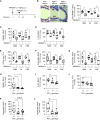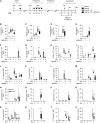Targeting the P2Y13 Receptor Suppresses IL-33 and HMGB1 Release and Ameliorates Experimental Asthma
- PMID: 34860143
- PMCID: PMC12042653
- DOI: 10.1164/rccm.202009-3686OC
Targeting the P2Y13 Receptor Suppresses IL-33 and HMGB1 Release and Ameliorates Experimental Asthma
Abstract
Rationale: The alarmins IL-33 and HMGB1 (high mobility group box 1) contribute to type 2 inflammation and asthma pathogenesis. Objectives: To determine whether P2Y13-R (P2Y13 receptor), a purinergic GPCR (G protein-coupled receptor) and risk allele for asthma, regulates the release of IL-33 and HMGB1. Methods: Bronchial biopsy specimens were obtained from healthy subjects and subjects with asthma. Primary human airway epithelial cells (AECs), primary mouse AECs, or C57Bl/6 mice were inoculated with various aeroallergens or respiratory viruses, and the nuclear-to-cytoplasmic translocation and release of alarmins was measured by using immunohistochemistry and an ELISA. The role of P2Y13-R in AEC function and in the onset, progression, and exacerbation of experimental asthma was assessed by using pharmacological antagonists and mice with P2Y13-R gene deletion. Measurements and Main Results: Aeroallergen exposure induced the extracellular release of ADP and ATP, nucleotides that activate P2Y13-R. ATP, ADP, and aeroallergen (house dust mite, cockroach, or Alternaria antigen) or virus exposure induced the nuclear-to-cytoplasmic translocation and subsequent release of IL-33 and HMGB1, and this response was ablated by genetic deletion or pharmacological antagonism of P2Y13. In mice, prophylactic or therapeutic P2Y13-R blockade attenuated asthma onset and, critically, ablated the severity of a rhinovirus-associated exacerbation in a high-fidelity experimental model of chronic asthma. Moreover, P2Y13-R antagonism derepressed antiviral immunity, increasing IFN-λ production and decreasing viral copies in the lung. Conclusions: We identify P2Y13-R as a novel gatekeeper of the nuclear alarmins IL-33 and HMGB1 and demonstrate that the targeting of this GPCR via genetic deletion or treatment with a small-molecule antagonist protects against the onset and exacerbations of experimental asthma.
Keywords: GPCR; alarmin; epithelium; pneumonia virus of mice; purinergic; rhinovirus.
Figures






Comment in
-
An Alarmin Role for P2Y13 Receptor during Viral-driven Asthma Exacerbations.Am J Respir Crit Care Med. 2022 Feb 1;205(3):263-265. doi: 10.1164/rccm.202111-2571ED. Am J Respir Crit Care Med. 2022. PMID: 34936856 Free PMC article. No abstract available.
Similar articles
-
Chronic IL-33 expression predisposes to virus-induced asthma exacerbations by increasing type 2 inflammation and dampening antiviral immunity.J Allergy Clin Immunol. 2018 May;141(5):1607-1619.e9. doi: 10.1016/j.jaci.2017.07.051. Epub 2017 Sep 22. J Allergy Clin Immunol. 2018. PMID: 28947081
-
GLUT1 mediates the release of HMGB1 from airway epithelial cells in mixed granulocytic asthma.Biochim Biophys Acta Mol Basis Dis. 2024 Mar;1870(3):167040. doi: 10.1016/j.bbadis.2024.167040. Epub 2024 Jan 27. Biochim Biophys Acta Mol Basis Dis. 2024. PMID: 38281711
-
Tollip deficiency exaggerates airway type 2 inflammation in mice exposed to allergen and influenza A virus: role of the ATP/IL-33 signaling axis.Front Immunol. 2023 Dec 6;14:1304758. doi: 10.3389/fimmu.2023.1304758. eCollection 2023. Front Immunol. 2023. PMID: 38124753 Free PMC article.
-
Alarmins in Osteoporosis, RAGE, IL-1, and IL-33 Pathways: A Literature Review.Medicina (Kaunas). 2020 Mar 19;56(3):138. doi: 10.3390/medicina56030138. Medicina (Kaunas). 2020. PMID: 32204562 Free PMC article. Review.
-
Epithelial alarmins: a new target to treat chronic respiratory diseases.Expert Rev Respir Med. 2023 Jul-Dec;17(9):773-786. doi: 10.1080/17476348.2023.2262920. Epub 2023 Oct 27. Expert Rev Respir Med. 2023. PMID: 37746733 Review.
Cited by
-
MLKL Regulates Rapid Cell Death-independent HMGB1 Release in RSV Infected Airway Epithelial Cells.Front Cell Dev Biol. 2022 May 31;10:890389. doi: 10.3389/fcell.2022.890389. eCollection 2022. Front Cell Dev Biol. 2022. PMID: 35712662 Free PMC article.
-
Anti-CCL2 therapy reduces oxygen toxicity to the immature lung.Cell Death Discov. 2024 Jul 3;10(1):311. doi: 10.1038/s41420-024-02073-5. Cell Death Discov. 2024. PMID: 38961074 Free PMC article.
-
Revealing the role of Peg13: A promising therapeutic target for mitigating inflammation in sepsis.Genet Mol Biol. 2024 May 31;47(2):e20230205. doi: 10.1590/1678-4685-GMB-2023-0205. eCollection 2024. Genet Mol Biol. 2024. PMID: 38856110 Free PMC article.
-
The Role of Defective Epithelial Barriers in Allergic Lung Disease and Asthma Development.J Asthma Allergy. 2022 Apr 18;15:487-504. doi: 10.2147/JAA.S324080. eCollection 2022. J Asthma Allergy. 2022. PMID: 35463205 Free PMC article. Review.
-
P2Y13 receptor deficiency favors adipose tissue lipolysis and worsens insulin resistance and fatty liver disease.JCI Insight. 2024 Mar 12;9(8):e175623. doi: 10.1172/jci.insight.175623. JCI Insight. 2024. PMID: 38470490 Free PMC article.
References
-
- Schmitz J, Owyang A, Oldham E, Song Y, Murphy E, McClanahan TK, et al. IL-33, an interleukin-1-like cytokine that signals via the IL-1 receptor-related protein ST2 and induces T helper type 2-associated cytokines. Immunity . 2005;23:479–490. - PubMed
-
- Shim EJ, Chun E, Lee HS, Bang BR, Kim TW, Cho SH, et al. The role of high-mobility group box-1 (HMGB1) in the pathogenesis of asthma. Clin Exp Allergy . 2012;42:958–965. - PubMed
-
- Zhou B, Comeau MR, De Smedt T, Liggitt HD, Dahl ME, Lewis DB, et al. Thymic stromal lymphopoietin as a key initiator of allergic airway inflammation in mice. Nat Immunol . 2005;6:1047–1053. - PubMed
-
- Werder RB, Lynch JP, Simpson JC, Zhang V, Hodge NH, Poh M, et al. PGD2/DP2 receptor activation promotes severe viral bronchiolitis by suppressing IFN-λ production. Sci Transl Med . 2018;10:eaao0052. - PubMed
Publication types
MeSH terms
Substances
LinkOut - more resources
Full Text Sources
Medical
Molecular Biology Databases

